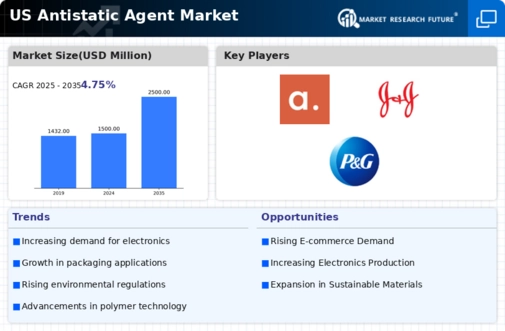Rising Awareness of ESD Risks
There is a growing awareness among manufacturers and consumers regarding the risks associated with electrostatic discharge (ESD). This heightened awareness is driving the demand for antistatic agents across various industries, including electronics, packaging, and textiles. As companies recognize the potential financial losses due to ESD-related damages, investments in antistatic solutions are increasing. The antistatic agent market is experiencing a shift as businesses prioritize the implementation of effective ESD control measures. This trend is expected to continue, with a projected growth rate of around 6% annually in the coming years, reflecting the increasing importance of safeguarding electronic components and sensitive materials from static-related issues.
Increased Regulatory Standards
The implementation of stricter regulatory standards concerning ESD control is a significant driver for the antistatic agent market. Regulatory bodies are increasingly mandating the use of antistatic solutions in industries such as electronics and pharmaceuticals to ensure product safety and compliance. As companies strive to meet these regulations, the demand for effective antistatic agents is expected to rise. The antistatic agent market is likely to benefit from this trend, as manufacturers invest in compliant solutions to avoid penalties and enhance their market reputation. This regulatory push is anticipated to contribute to a steady growth trajectory for the antistatic agent market, with an estimated increase of 4% in demand over the next few years.
Expansion of the Packaging Industry
The packaging industry in the US is undergoing significant expansion, which is positively impacting the antistatic agent market. With the rise of e-commerce and the need for protective packaging solutions, the demand for antistatic agents is increasing to prevent static-related damage during shipping and handling. In 2025, the US packaging market is projected to exceed $200 billion, creating substantial opportunities for antistatic agent manufacturers. The antistatic agent market is poised to capitalize on this growth, as companies seek to enhance the safety and integrity of their packaged products. This trend is likely to drive innovation and the development of specialized antistatic solutions tailored for various packaging applications.
Growth in Electronics Manufacturing
The expansion of the electronics manufacturing sector in the US is a primary driver for the antistatic agent market. As the production of electronic components increases, the need for effective antistatic solutions becomes critical to prevent damage from electrostatic discharge (ESD). In 2025, the electronics manufacturing industry is projected to reach a value of approximately $1 trillion, indicating a robust demand for antistatic agents. These agents are essential in protecting sensitive electronic devices during production and handling, thereby ensuring product reliability and longevity. The antistatic agent market is likely to benefit significantly from this growth, as manufacturers seek to enhance their production processes and minimize defects caused by static electricity.
Technological Advancements in Antistatic Solutions
Innovations in antistatic agent formulations and applications are significantly influencing the antistatic agent market. Recent advancements have led to the development of more efficient and environmentally friendly antistatic agents, which are gaining traction among manufacturers. These new formulations not only provide superior performance but also align with the growing demand for sustainable products. The market for advanced antistatic agents is expected to grow at a CAGR of approximately 5% through 2028, driven by the need for enhanced performance in various applications. As industries adopt these innovative solutions, the antistatic agent market is likely to see increased competition and diversification in product offerings.

















Leave a Comment